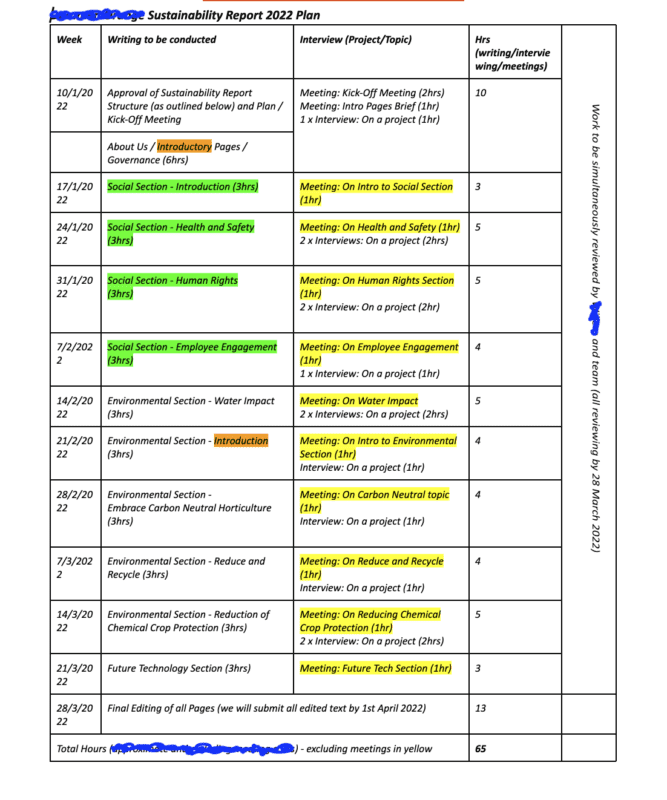An Impact Report is another word for a Sustainability Report or ESG report. Over the last few years, I’ve been extensively involved in Impact Reports for clients and sustainability communication, which is becoming increasingly popular and widespread.
What is an Impact Report Exactly?
The phrase ‘Impact Report’ is gaining popularity as the emphasis lies on a company’s impact on the environment and people. I’ve come to prefer the term ‘Impact Report’ rather than ‘Sustainability Report,’ as the latter is becoming a little overdone nowadays.
Below are my top tips — things I’ve learned over the last few years — when creating an Impact Report. I hope these tips help you refine your publication and make it top-notch!
1. Ensure Alignment with Your Company’s Sustainability Strategy
My first tip is to ensure that all relevant sections are included in your Report. You must determine if your chosen sections align with your company’s sustainability strategy. It would be best to do external research on various Impact Reports to ensure you’ve included all the relevant sections generally included in such a report (consider also reports from competitors and related companies within your industry). Of course, the sections you choose depend on your company and what needs to be reported — mandatory points for reporting according to various regulations (or what your company wants or would like to report on for its stakeholders).
2. Engage Stakeholders with Genuine Writing
Ensure authentic language is used in your Impact Report. Avoid using tools such as ChatGPT to create dry or over-the-top texts. While you can use ChatGPT for basic text drafting or error correction, I highly recommend engaging, impactful, and authentic writing that reaches the required stakeholders and audience. An engaging Impact Report is much more pleasant and interesting for a diverse set of stakeholders than one that is merely computer-generated and that anyone can create with the help of AI tools.
3. Plan for Thorough Execution
Ensure a strong structure from the onset of your Impact Report. Map out and plan the contents of your Impact Report before delving into the details of each section. A strong plan ensures that you will execute it accordingly, more thoroughly, and professionally. You can create a basic table of contents in Microsoft Word or Google Docs or use a single A4 page with a table to map out what sections need to be included and get sign-off for those sections. Below is an example of a plan I’ve created for my clients to guide them in the creation of an Impact Report publication:

4. Infuse Stories and Case Studies
Include inspiring sustainability stories and case studies in your Report. An Impact Report isn’t just about statistics; it’s about the real impact your company or organization has on people and the environment. Therefore, include tangible and interesting case studies and inspiring sustainability stories to intersperse with statistics or tables of statistics, which may be seemingly more dry or boring.
5. Foster Trust through Openness
Be transparent and accountable in your Impact Report. Use transparent language and take accountability for the company’s actions in the report. This means mentioning the things you cannot yet report on (and carefully explaining how you’ll get there!), ensuring you’re not biased, and not engaging in greenwashing. By being open and transparent, you will gain the respect of your stakeholders, employees, and potential employees going forward.
6. Enhance Accessibility with Interactive Formats for Your Impact Report
Create different visual versions of your Impact Report for variation and accessibility. Opt for an interactive PDF or landing page to show your statistics using infographics, diagrams, graphs, charts, case studies, and inspiring stories. This ensures accessibility and reduces environmental impact compared to a print version. A nice example of an interactive report I came across recently is the one below from Erasmus University Rotterdam (not, I’m not endorsing the text as I’ve noticed some errors therein, but the overall layout and design are super):
Impact Report Example from Erasmus University Rotterdam:
7. Maintain Balance for Objectivity
Ensure that all sections of your Impact Report receive equal attention. Avoid bias by giving equal attention to each section. Review the length of each section to ensure balance; if one section is longer, consider cutting down on the number of words to maintain balance.
8. Summarize with Forward-Looking Insights
Ensure you conclude your Report properly. Many of the Impact Reports that I’ve seen merely end without any conclusion, summary, or wrap-up at the very end. An Impact Report needs to conclude with some forward-looking statements. A paragraph or two is sufficient for the conclusion.
9. Showcase Collaborative Impact
Ensure that you include information about partner organizations with whom you’re working to improve the environment and people. Many companies need to remember how they are partnering with stakeholders and companies from their supply chain on sustainability. This is very, very important. You may, for example, be engaged in a project with another company in the same country. And you may want to document and show how this project has benefited the employees or the environment, for example. This can also take the form of an inspiring case study or story.
10. Ensure a Unified Tone and Style in Your Impact Report
Use consistent language, tone, and style throughout your Impact Report. While you may adjust the language in certain sections for effect, ensure overall consistency to maintain clarity and professionalism. Have someone copy-edit the entire Impact Report to ensure consistency throughout.
Thanks for reading to the end of my post ’10 Tips for Creating an Impact Report.’
If you want to learn more about my Impact Report Writing and Design services, please contact me at info@elizabethjoss.com.
